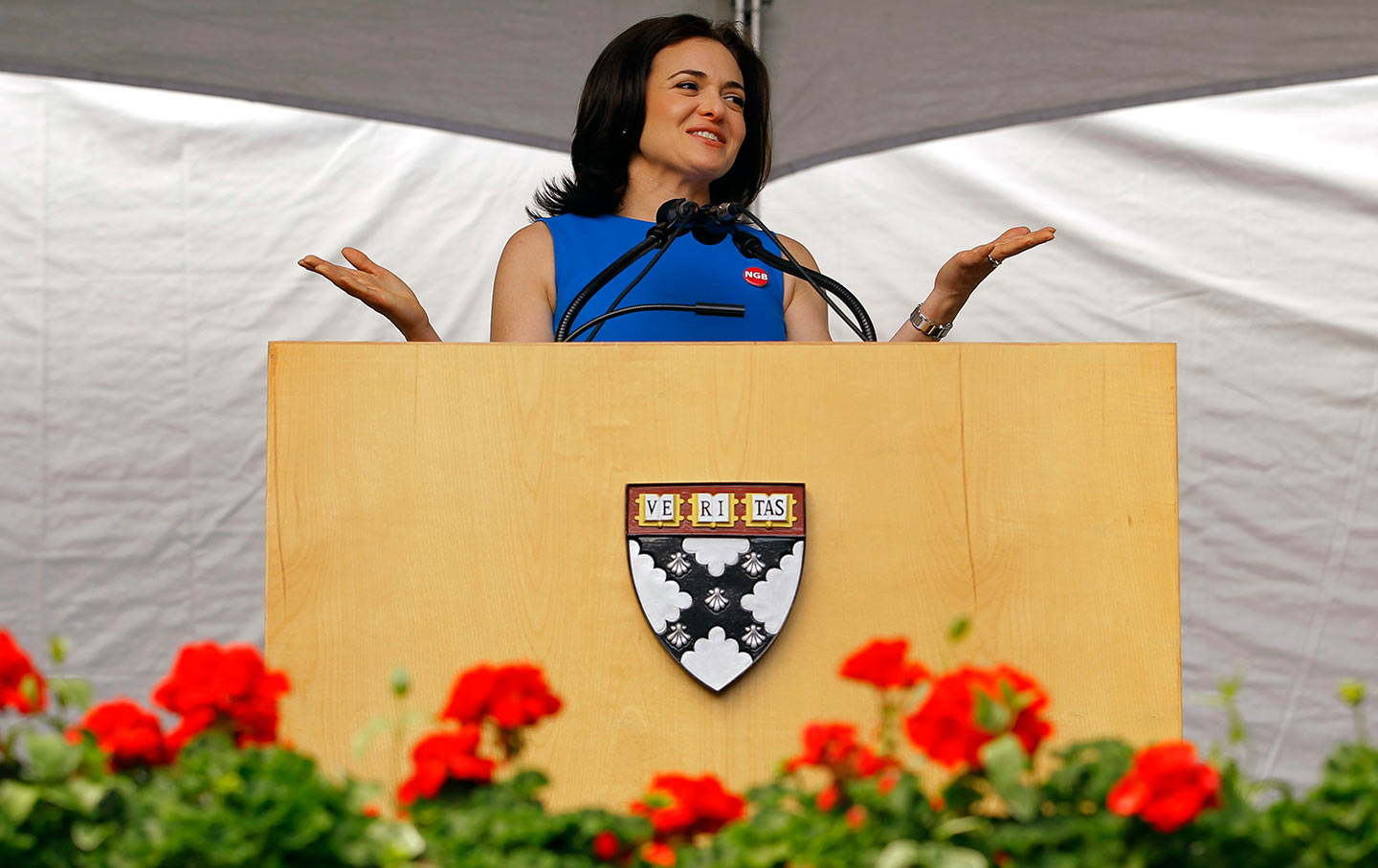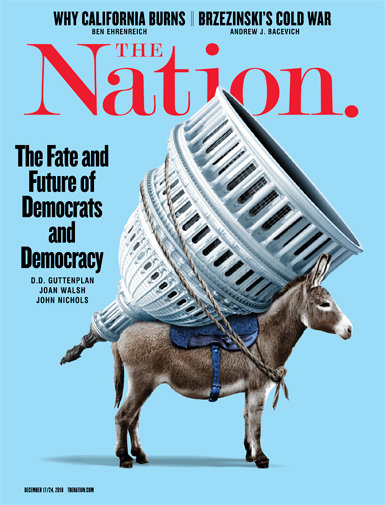The Media isn't "Polarized", It Has a Right-Wing Cancer
As individuals, liberals and conservatives share all the failings humans are prone to. But left-wing media and right-wing media are structured differently, and the implications are huge.
What's the difference between right-wing media and left-wing media? Or between conservatives and liberals in general? If you have an answer, how do you know that your answer is objective, rather than just a reflection of your own bias? (As John Lockeobserved more than three centuries ago: "Everyone is orthodox to himself.") Or if you think there is no difference, couldn't your both-sides-ism itself be a bias? Wouldn't it be odd if Right and Left had exactly the same levels of reasonability or factuality?
How would you know?
Network Propaganda. In Network Propaganda, (whose text and illustrations are available free online, as well as for sale as a book or e-book) Yochai Benkler, Robert Faris, and Hal Roberts go to great lengths to produce an objective look at how news travels through the different regions of the US political universe.
It starts with data.
We collected and analyzed two million stories published during the 2016 presidential election campaign, and another 1.9 million stories about the Trump presidency during its first year. We analyze patterns of interlinking between the sites to understand the relations of authority and credibility among publishers high and low, and the tweeting and Facebook sharing practices of users to understand attention patterns to these media.
What they found overall looks like this:
This aggregate view of the open web link economy during the 2016 election period shows a marked difference between the right and everything that is not the right. There is a clear overlap and interaction between the left, center-left, and center media outlets. These are all centered on the cluster of professional, mainstream journalism sites: the Washington Post, the New York Times, CNN, and Politico form a basin of attraction for outlets ranging from the editorially conservative Wall Street Journal, ABC News, Business Week, or USA Today, through the liberally oriented MSNBC. Zooming in, we see that the right side of the spectrum, by contrast, has Breitbart and Fox News as its basin of attraction, has almost no overlap with the center, and is sharply separated from the rest of the map. The other leading sites on the right include the New York Post, the Washington Times, the Daily Caller, the Daily Mail, and the Washington Examiner. There is almost no center-right, and what there is, anchored around the National Review, is distinct from the set of sites anchored by Fox and Breitbart on the right. The Huffington Post, the Guardian, and MSNBC receive the largest number of media inlinks on the left, joined by Mother Jones, Slate, Vox, and Salon.
Dynamics. This structure produces two distinct dynamics on the left and right. People of all persuasions like to have their prior opinions reinforced, and so we are all susceptible to clickbait (fantastic headlines that appeal to our biases, but have no real substance) and fake news (made-up or grossly exaggerated stories that we want to believe). So both kinds of disinformation are constantly being produced on the extreme Left and Right alike. The difference is what happens then.
there is ample supply of and demand for false hyperpartisan narratives on the left. The difference is that the audience and hyperpartisan commercial clickbait fabricators oriented toward the left form part of a single media ecosystem with center, center-left, and left-wing sites that are committed to journalistic truth-seeking norms. Those norm-constrained sites, both mainstream and net-native, serve as a consistent check on dissemination and validation of the most extreme stories when they do emerge on the left, and have no parallels in the levels of visibility or trust that can perform the same function on the right.
In other words: False stories that come from the Left drift towards the center and get debunked. And that's usually the end of them. Sites on the far Left know that a lot of their audience also listens to NPR or reads The New York Times. Even if a story has to make it all the way to the center-right (The Wall Street Journal, say, or National Review) before it gets shot down, the correction will filter back, making left-wing sites look bad if they keep repeating the false information.
Nothing similar happens on the Right.
Dynamics on the right tend to reinforce partisan statements, irrespective of their truth, and to punish actors—be they media outlets or politicians and pundits—who insist on speaking truths that are inconsistent with partisan frames and narratives dominant within the ecosystem.
In other words, the right-wing news ecosystem has no antibodies that fight infection by false information. Left and Right are each exposed to misinformation and disinformation, but nothing on the Right keeps it from taking root.
It is not that Republicans are more gullible, or less rational, than Democrats. It is not that technology has destroyed the possibility of shared discourse for all. It is the structure of the media ecosystem within which Republican voters, whether conservatives or right-wing radicals, on the one hand, and Republican politicians, on the other hand, find themselves that made them particularly susceptible to misperception and manipulation, while the media ecosystem that Democrats and their supporters occupied exhibited structural features that were more robust to propaganda efforts and offered more avenues for self-correction and self-healing.
Examples. The book illustrates this bifurcated pattern with
parallel but politically divergent false rumors, about Trump raping a 13-year-old and Hillary and Bill Clinton being involved in pedophilia, [and how the rumors] followed fundamentally different paths through the media ecosystems into which each was introduced.
The Trump-rape story was based on a Jane Doe lawsuit. It made an initial splash on the Left, as Democrats on social media shared and reposted a Huffington Post article arguing that the case deserved media attention. But the same day as the HuffPost article, The Guardian ran a skeptical article, claiming the suit had been "orchestrated by an eccentric anti-Trump campaigner with a record of making outlandish claims about celebrities." Within a week the story had virtually vanished, even from very liberal news sources.
The Clinton pedophilia story, on the other hand, began in May, 2016 and continued to rattle through the right-wing echo chamber for the rest of the campaign.
Newt Gingrich, former Speaker of the House of Representatives, made the accusation on-air, interviewed by Sean Hannity and by Greta Van Susteren on Fox News. Bret Baier, anchoring Fox News's prime-time news show ran a detailed segment on the accusations of Bill Clinton flying to Orgy Island on the Lolita Express. Fox News online published the underlying materials. Rush Limbaugh discussed the allegation as something everyone knows. Trump's campaign adviser and national security adviser in waiting, Michael Flynn, tweeted it out. Breitbart, the most widely shared right-wing online site whose on-leave CEO Steve Bannon was then running Trump's campaign, aired an interview constructed of pure disinformation. It seems highly unlikely that any of the people involved—Prince, Flynn, or the publishers of Breitbart—thought that the accusation that Hillary Clinton had flown six times to Orgy Island was anything other than utterly false, and yet they published it four days before the election on Breitbart's radio station and online. Not one right-wing outlet came out to criticize and expose this blatant lie for what it was. [my emphasis] In the grip of the propaganda feedback loop, the right-wing media ecosystem had no mechanism for self-correction, and instead exhibited dynamics of self-reinforcement, confirmation, and repetition so that readers, viewers, and listeners encountered multiple versions of the same story, over months, to the point that both recall and credibility were enhanced. It is hardly surprising, then, that a YouGov poll from December 2016 found that over 40 percent of Republican respondents thought that it was at least somewhat likely that someone was running a pedophilia ring out of the Clinton campaign.
This disinformation had real-world consequences. In December, a young man fired three shots in a DC-area pizza restaurant supposedly involved in the pedophilia ring.
Despite extensive efforts, we were unable to find an example of disinformation or commercial clickbait started on the left, or aimed from abroad at the left, that took hold and became widely reported and believed in the broader network that stretches from the center to the left for any meaningful stretch of time
A second set of examples came from the "fake news awards" President Trump announced in 2017.
Comparing the Uranium One, Seth Rich, and Lolita Express and Orgy Island diffusion patterns we observed in earlier chapters on the one hand, and the various winners of the "fake news awards" on the other hand, underscores the fundamentally different dynamics in the right wing as compared to the rest of the American political media ecosystem. When observing right-wing conspiracy theories, we saw positive feedback loops between the core of that network—composed of Fox News, leading Republican pundits, and Breitbart—and the remainder of the online right-wing network. In those cases we saw repetition, amplification, and circling of the wagons to criticize other media outlets when these exposed the errors and failures of the story. By contrast, the mainstream media ecosystem exhibited intensive competition to hold each other to high journalistic standards, and a repeated pattern of rapid removal of content, correction, and in several cases disciplining of the reporters involved. Moreover, in none of these cases did we find more than a smattering of repetition and amplification of the claims once retracted.
Why doesn't the Left do the same thing? This is one of the book's more interesting points. People watch news programs for two purposes: to stay informed and to have their worldview reaffirmed. Since the 1980s, the Right has established an alternate news system that primarily serves the second purpose. But this isn't just an ideological crusade, it also makes money.
So why doesn't a parallel system make money on the Left? (It's been tried. Air America tried to establish liberal talk radio during the Bush years, but went bankrupt.) Various liberal news outlets exist, but they've never escaped from the mainstream news ecosystem. It's tempting to claim some superior virtue on the Left, but that's not where Network Propaganda goes. Instead, it finds a first-mover advantage: Once a self-contained right-wing propaganda system exists, it allows the left-wing audience to gets its worldview affirmation from the center.
But once one wing has established the strategy of partisan bias confirmation, the centrist media with their truth-seeking institutions and reputations suddenly deliver a new benefit to partisans of the opposite pole—as objective external arbiters they can offer institutionalized credibility to reinforce their view that what their opposition is saying is false. Once one partisan media pole is established, the coverage of existing objective media outlets takes on a partisan flavor without any shift in their own focus on objectivity.
The mainstream media will be able to reconcile their goals of truth-seeking and confirmation from the center with providing a steady flow of partisan-confirming news for the wing in opposition to the wing that is already in the grip of the propaganda feedback loop. The outlets that formed the partisan ecosystem have a first-mover advantage over outlets that try to copy them on the opposite side, because as they decrease the value of the mainstream media to their own audiences, they increase it for the putative audiences of their opponents. The further the first-moving partisan media ecosystem goes down the path of its own propaganda feedback loop, the greater its tendency to produce untrue statements, and the greater the opportunities for reality-check centrist media organizations to deliver news that is both truthful and pleasing to partisans from the other side.
Fox is not a news network. During the primary campaign, Fox News represented traditional conservatism and was skeptical of Trump. Consequently, it lost ground to Breitbart as the center of right-wing coverage. After the election, though, it regained its standing by going full Trump.
Chapter 5, "The Fox Diet", demonstrates how not just the content, but the timing, of Fox coverage derived from what the Trump administration needed, rather than what was new or true or relevant.
One case involves the argument that Democratic activist Seth Rich was murdered to hide the fact that he, not Russia, was responsible for leaking the Democratic National Committee (DNC) emails. The other case involves use of a story surrounding a company called Uranium One to attack the integrity and independence of the key law enforcement officers involved in the special counsel investigation. The timing and pattern we show in these case studies strongly suggest that they were launched for the specific partisan purpose of deflecting the Trump-Russia allegations and undermining the special counsel investigation. And in the two specifically fact-based cases, we show that Fox News actively promoted these stories despite the fact that they were repeatedly fact checked and debunked by a wide variety of professional journalists.
Both the Seth Rich and Uranium One stories had initially flared and died down, but re-emerged months or even years later when Trump needed them to shift the narrative. Uranium One was initially an anti-Clinton story early in the campaign, but was repackaged after the election as an Deep-State-law-enforcement story when the Mueller investigation heated up and Trump needed to undermine its credibility.
Manipulating the mainstream media. The existence of a propaganda network, one that constantly accuses traditional journalists of bias, puts those journalists under constant pressure to prove their objectivity. Often this takes the form of "balance" — finding a negative story about one side to balance a negative story about the other.
a core driver of the [Clinton] email focus was misapplication of the objectivity norm as even-handedness or balance, rather than truth seeking. If professional journalistic objectivity means balance and impartiality, and one is confronted with two candidates who are highly unbalanced—one consistently lies and takes positions that were off the wall for politicians before his candidacy, and the other is about as mainstream and standard as plain vanilla—it is genuinely difficult to maintain balanced coverage. The solution was uniformly negative coverage, as Patterson and colleagues showed, and a heavy focus on detailed objective facts. The emails were catnip for professional journalists. They gave journalists something concrete to work with. They had the aura of salacious reporting of uncovered secrets, while being unimpeachably factual and professional. And they allowed the mainstream publications to appear balanced in that their coverage of the two candidates was equally hard-hitting and tough.
The result was that Trump by far got the advantage of news coverage during the campaign: Coverage of Clinton tended to be about scandals, many of which had dubious substance. Trump, on the other hand, got covered for his positions on immigration, jobs, and trade.
Articles about Clinton in The New York Times and Washington Post often had scandalous headlines that were walked back by details far down the column. Such articles were frequently cited on the Right (as NYT and WaPo stories seldom are) to validate an anti-Clinton narrative.
Consider where the actual balance-of-scandals tilted: the Trump sexual harassment stories had numerous first-person witnesses, while the Trump University fraud eventually required a $25 million settlement. Supposed scandals about the Clinton Foundation were almost entirely conspiracy theories, while the largely uninvestigated Trump Foundation is currently facing a lawsuit calling for its dissolution for self-dealing. And yet this was the balance of coverage:

The Right needs this kind of mainstream cooperation, because the number of people who live inside the right-wing bubble is somewhere iin the range of 25-30% of the population — not nearly enough to win elections.
Russia and other bad actors. The good news in the book is the authors' conclusion that Russian social media campaigns, fake news entrepreneurs, Cambridge Analytica, and Facebook's news algorithms actually had little effect on the course of news coverage.
The Russians tried but were unlikely to have been a critical factor. The commercial bullshit artists made some money, but were peripheral. And while Facebook's data team certainly did make it possible for a complete outsider running with little help from party institutions to identify millions of voters and reach out to them effectively, the Cambridge Analytica manipulative advertising and the dark ads part of the story was still, in 2016, more of a red herring than the game changer some made it out to be.
[Note: This is about the effectiveness of Russian social media campaigns. No one disputes that the DNC emails hacked by the Russians and distributed by WikiLeaks had a major impact.]
However, the existence of a right-wing propaganda ecosystem, with correspondingly low resistance to false facts it wants to believe, is a continuing vulnerability in the American political system. As long as it exists, it will be open to outside manipulation.
Russian propaganda seems to have targeted both sides, and Facebook clickbait sites tried to manipulate denizens of all sides of the American public sphere. But, just as we saw in the case of the competing Trump rape and Clinton pedophilia frames, the responsiveness and success appear to have been very different in the two parts of the media ecosystem. In the right-wing media the propaganda feedback loop enabled conspiracy theories, false rumors, and logically implausible claims to perform better, survive longer, and be shared more widely than were parallel efforts aimed at the left.
The authors also saw little effect from far-right-wing groups (like white supremacists) seeding their messages into the right-wing core. The problem wasn't that VDare or The Daily Stormer manipulated Fox News into spreading racist anti-immigrant messages, but that Fox went looking for those memes.
In general,
a population with high trust in bias-confirming news and high distrust in bias-disconfirming, professional-norms-driven media will be more vulnerable to disinformation campaigns than a population that has generally higher trust in professional journalism on average, but lower trust in any given media outlet…. As Joanne Miller and her collaborators and, independently, Adam Berinsky have shown, for Democrats, the more knowledgeable they are about politics, the less likely they are to accept conspiracy theories or unsubstantiated rumors that harm their ideological opponents. But for Republicans more knowledge results in, at best, no change in the rate at which they accept conspiracy theories, and at worst, actually increases their willingness to accept such theories.
What can be done? Something, but not a lot. Mainstream media needs to recognize that it lives in a propaganda-rich environment, and that the propaganda does not come equally from both sides.
When mainstream professional media sources insist on coverage that performs their own neutrality by giving equal weight to opposing views, even when one is false and the other is not, they fail. … [T]he present journalistic practice of objectivity as neutrality has perverse effects in the media ecosystem we document here. By maintaining the "one side says x, the other side says y" model of objectivity in the presence of highly asymmetric propaganda efforts, mainstream media become sources of legitimation and amplification for the propagandists.
Instead of balance, mainstream journalism needs to focus on truth-seeking and accountability. The authors make an interesting suggestion about, for example, anonymous sources. A responsible editor will insist on knowing a reporter's sources, but an irresponsible organization could abuse that practice. What if some independent, highly trusted organization were set up that news organizations could use to verify their anonymous sources without revealing them? The system might function like peer review in science.
Journalists also need to apply skepticism to illicitly obtained documents that come from, say, Russian hackers rather than whistle-blowers.
Recognizing the asymmetry we document here requires editors to treat tips or "exclusives," as well as emails or other leaked or hacked documents with greater care than they have in the past few years. The "Fool me once, shame on you . . ." adage suggests that after, for example, the New York Times's experience with Peter Schweizer and the Uranium One story, mainstream professional journalists need to understand that they are subject to a persistent propaganda campaign trying to lure them into amplifying and accrediting propaganda. This happens of course as normal politics from both sides of the partisan system, but our work here shows that one side is armed with a vastly more powerful engine for generating and propagating propaganda.
But ultimately the Right will have to fix itself. It may seem far-fetched at the moment, but traditional conservatives (as opposed to white supremacists or other right-wing extremists) must already realize that the current system is not working for them.
There is nothing conservative about calling career law enforcement officials and the intelligence community the "deep state." The fact that the targets of the attack, like Robert Mueller, Rod Rosenstein, or Andrew McCabe, were life-long Republicans merely underscores that fact. There is nothing conservative about calling for a trade war. There is nothing conservative about breaking from long-held institutional norms for short-term political advantage. And there is nothing conservative about telling Americans to reject the consensus estimate of the CIA, the FBI, and the NSA that we were attacked by Russia and suggesting instead that these agencies are covering up for a DNC conspiracy. What has happened first and foremost to make all these things possible is that the Republican Party has been taken over by ever-more right-wing politicians.
The authors suggest that a series of election losses might motivate such a re-assessment of where the trends of the last 30 years have brought the conservative movement. Network Propaganda was published prior to the recent midterm elections, but we can hope that 2018 was the first in a series of such losses.




 A recent study underscores how human-caused global warming could annihilate life through co-extinction of species.
A recent study underscores how human-caused global warming could annihilate life through co-extinction of species.




Comments
This is terrific as is the availability of the book online. Not only with the right, and the Republicans have to fix this, the political far left need to fix themselves as well. Too much paranoia and extreme conclusions about understandable events resulting in distracting conspiracy theories.
I feel like we read different articles. The point was the the false stuff from the left dies relatively quickly. The fringy stuff stays fringy, exactly as one would want. Given the context of this article, this feels a lot like the sort of bogus "balance" that is part of the problem.
Unfortunately history has taught us that the fascists will not fix themselves.
Another thing that may be somewhat responsible for the disparity in how the two sides handle falsehoods rests in their values. I read something once (and have been trying to find it again for years) that was a list of the values of the left and the right– the lists were the same, but in opposite priority order. The right's number one value is loyalty, while the left's top value is honesty. Honesty is at the bottom for the right, and loyalty is at the bottom for the left.
Since the right values loyalty above honesty, it would be more prone to attacking criticism of a propaganda story, while on the left, when someone attacks a false story for being false, people tend to respond with "thank you for telling me".